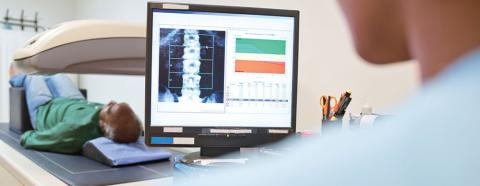
Don't wait for a break
Prevent osteoporosis now
By Rhea Maze
 It’s a disease you can’t feel.
It’s a disease you can’t feel.
Osteoporosis, a condition characterized by a loss of bone density resulting in the bones weakening, is one of the most under-diagnosed health problems in the U.S. because it has no symptoms.
“Low bone density is not painful. For many people, the first clue is a broken bone,” says Daen Scott, a family nurse practitioner specializing in osteoporosis and diabetes at UCHealth. “This is why prevention and screening are key.”
Aging can lead to a gradual loss of bone density, and due to estrogen changes during menopause, women tend to develop osteoporosis earlier than men. The most common risk factors for developing osteoporosis or osteopenia, which is lower than normal bone density that has not yet become osteoporosis, include aging, having a low body weight, malnutrition, smoking, excessive alcohol intake, a relevant family history, and some medical conditions and treatments.
When diagnosed with osteoporosis or osteopenia, health-care providers may advise patients to increase calcium and/or vitamin D intake, exercise, improve their diet, and continue to monitor the condition with regular screening. Medications may also be prescribed.
“The most important thing to keep in mind is that the majority of osteoporosis treatments do a better job of keeping the bone you have than increasing it, so the earlier it’s caught and dealt with the better your odds are of avoiding a broken bone,” Scott says.
To preserve or improve the bone mass you have, Scott recommends making sure you get plenty of vitamin D and calcium as part of an overall healthy diet, quit smoking, and talk with your health-care provider about screening. Doing weight-bearing exercise such as working out with weights, resistance training, or yoga that includes all the major muscle groups, at least two times per week is key to prevention as well.
And it’s never too early to incorporate these prevention practices, because childhood health can affect bone density later in life.
“Osteoporosis is silent until the bones start breaking,” Scott says. “Talk to your health-care provider about screening and consider what you can do to maintain good nutrition and lots of activity.”
| Get Screened |
|---|
|
| Did you know? |
|---|
Source: The National Osteoporosis Foundation, nof.org |